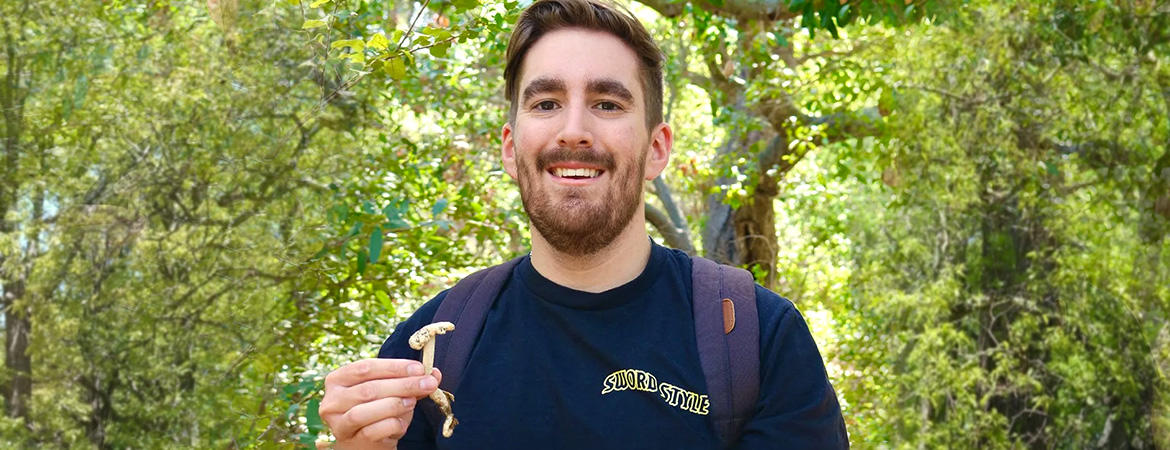
By Kathleen Wong, UC Natural Reserve System
When wildfires rage, fire retardants can slow or stop the spread of flames. These chemical mixes are often sprayed over large swaths of land, coating entire hillsides in stripes of yellow or red. In recent years, millions of gallons of fire retardants have been dropped in a single day to battle California’s ever larger and more severe fires.
How these retardants affect plants and their symbiotic microbial communities, however, is poorly understood.
“From what I could find there has been very little known. There’s been one study in a greenhouse setting, but as far as I can tell, there haven’t been in-depth field studies before,” says UC Riverside undergraduate Ryan Quaal.
Quaal plans to examine the role of Phos-Chek fire retardant on mycorrhizae, fungi associated with plant roots, with funding from an NRS Field Science Fellowship. Quaal will proceed with guidance from his fellowship mentor, UCR professor of microbiology and plant pathology Sydney Glassman. Quaal and Glassman were among three teams of fellows chosen to pursue field research projects over the summer of 2022. Each team will receive $5,000 for the undergraduate student and $1,000 for project costs.
A transfer student from community college, Quaal began working with Glassman as part of UC Riverside’s Summer Bridge to Research program. He learned to isolate bacterial and fungal specimens, and attended lab meetings with Glassman and her graduate students. When the topic of fire retardants and soil microbes was raised at one of those meetings, it sparked Quaal’s scientific interest.
“It just got me thinking about how it could definitely change the mycorrhizal fungi in the soil as well. Seeing those planes come overhead every summer and dropping more and more retardant is definitely concerning,” Quaal says.
“I knew that he was really enthusiastic about fungi and doing research. I reached out to him and asked if he was interested in applying for this fellowship. He came up with his own idea for the proposal, which I was really impressed with,” Glassman says.
Between 70 and 90 percent of plants are involved in symbiotic relationships with these mycorrhizal fungi, which extend their microscopic filaments directly into plant roots. Typically, the plant shares sugars it has generated from photosynthesis with the fungus, while the fungus delivers mineral nutrients and water it has gleaned from the soil. The extra access to resources often enhances the growth and disease resistance of participating plants.
But plants exposed to fire retardants, which contain large quantities of phosphorous and nitrogen, may be less willing to enter into partnerships with mycorrhizal fungi.
“I think it’s possible that there’s going to be really strong negative effects of these flame retardants on soil microbial communities. What the consequences of that are, are really unclear. It feels we should know, especially given how widespread the use of these retardants is,” Glassman says.
For his fellowship project, Quaal plans to spray Phos-Chek on plots at Emerson Oaks Reserve in Temecula, then come back weeks later to collect samples of both soils and oak tree roots. In the laboratory, he’ll determine whether plots treated with retardant have different amounts of fungal diversity, levels of root colonization, and root biomass than unsprayed plots. Along the way, he’ll develop skills such as spore identification, DNA sequencing, microscopy, and statistical analysis.
He’ll also get lots of chances to interact with both Glassman and her graduate students while both setting up the experiment and conducting the lab work. That will help Quaal obtain a deeper level of knowledge as well as advice from others further along in their careers, Glassman says. “There’s just a lot more opportunity for casual conversation when we go into the field, or work together on a project, than in a classroom setting where everything’s very structured.
For his part, Quaal feels the fellowship will raise his science game to the next level. “Hopefully this pushes me forward in terms of academics and maybe grad school later on,” says Quaal. “I definitely want to get some research that I can present at climate conferences.”
Glassman is extra pleased that the fellowship involves the NRS. She herself has worked at many NRS reserves for both her graduate and postdoctoral research, and is a past recipient of the NRS’s Mildred E. Mathias Graduate Student Research Grant.
“I feel the NRS is an unparalleled resource that we have as part of the UC system. Getting permits to do research is really difficult elsewhere. And the managers are a huge resource, they can tell you where is a good place to do your research, where I can find this plant, what kinds of plants are on reserves. It’s honestly something that keeps me in the UC system,” Glassman says.
Two other UC undergraduates and their faculty mentors will also receive Field Science Fellowships in 2022. At UC Santa Cruz, Astarte Brown will work with professor Roxanne Beltran to study how the presence of sharks affects diving behavior in northern elephant seals at Año Nuevo Island Reserve. At UC San Diego, Christopher Winters will examine whether nutritional subsidies from marine wrack boost populations of invasive Argentine ants at Scripps Coastal Reserve and other San Diego sites with guidance from professor David Holway.
Launched in 2020, the NRS Field Science Fellowship encourages students from backgrounds underrepresented in the field sciences to work with faculty while conducting research projects at NRS reserves. Fellowships are funded by the Samuelsen Conservation Scholars Initiative, which supports NRS diversity and inclusion efforts. The initiative honors the first director of the NRS, J. Roger Samuelsen.